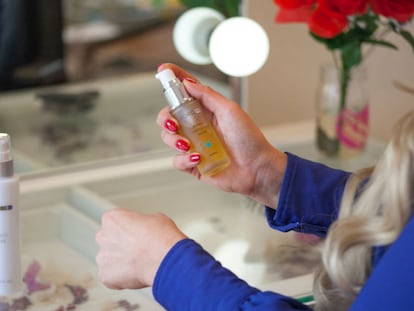How to use retinol body lotions effectively
Lovers of this vitamin A derivative use it to boost collagen and maintain firm, smooth skin, but success depends on how it’s applied

Retinol, a vitamin A derivative, has garnered widespread praise from both doctors and cosmeticians. This over-the-counter product is now available in body lotions, creams and eye applications, offering anti-aging and anti-acne benefits. While once mainly used in facial care, products like cellulite creams enriched with retinol are gaining popularity. “The sale of retinol products for other areas of the body was delayed due to challenges in stabilizing the molecule, potential skin irritation, and the preference for gentler ingredients,” said Silvia Giralt, the founder of an esthetic center in Spain that bears her name.
Retinol’s superpowers spurred interest in products for body care. It boosts collagen, controls oil and leaves skin soft and firm. Its benefits go even further — it fights melanin, reduces pigmentation, treats spots, scars, keratosis, acne and skin aging.
“The first retinol body products appeared about 15 years ago. The current boom is due to more scientific evidence regarding its benefits and the recent increase in demand for body-care products,” said David Fernández Polo, a skincare education specialist with Paula’s Choice in Spain, a brand that markets a body lotion with 0.1% retinol.
How is retinol in body-care products different from retinol for the face? “The texture is denser, more nutritious, and the retinol is less concentrated,” said Ana Santamarina, a dermocosmetics expert and creator of Sublime, a body treatment with micro-encapsulated retinol that stimulates collagen synthesis.
Micro-encapsulated formulations of retinol products are the most effective. “At LICO, we microencapsulate it in a cellulose polymer. This technique releases retinol slowly as needed by the skin, a process that takes about eight hours. Furthermore, the microcapsule penetrates beyond the first layer of the skin, so it offers a more in-depth treatment,” says LICO CEO Estefanía Ferrer’s blog.
Just like with the retinol products for the face, start applying it to the body gradually. Using too much retinol all at once can irritate the skin. “For products with very low concentrations, you can start off using it daily. For a 0.1% concentration, start by applying the lotion three or four nights a week. Be extra cautious in sensitive areas like the inner thighs,” said Santamarina.
Be careful when combining it with other skin creams, as it can cause redness. “It’s best to avoid using it after a physical or chemical exfoliation. Also, steer clear of mixing it with products containing AHAs,” said Santamarina. “It’s not a good idea to mix it with strong peroxides, alpha hydroxy acids (AHA), beta hydroxy acids (BHA), or certain high-concentration vitamin C products. It’s best to talk first with a specialist, like an esthetician or dermatologist for personalized advice. Retinol isn’t a one-size-fits-all solution,” said Giralt.
Retinol can be mixed with acids for certain skin types. “Studies show better results when combining retinol with AHA or BHA chemical exfoliants like Paula’s Choice products. Exfoliating beforehand enhances retinol penetration, restoring skin, reducing sun damage, hydrating, and unifying tone,” said David Fernández Polo. To maintain effectiveness, use retinol two or three times a week. Choose products that blend retinol with soothing ingredients like shea butter to reduce potential irritation or other adverse reactions.
And stay out of the sun. “Retinoids are sensitive to sunlight, so their effectiveness diminishes when exposed to rays. It’s best to apply them before bedtime, as the skin undergoes renewal processes called circadian cycles at night,” said Raquel González, a cosmetologist and technical director of Perricone MD, which markets a retinol body lotion called Cold Plasma Plus+ Fragile Skin Therapy.
Sign up for our weekly newsletter to get more English-language news coverage from EL PAÍS USA Edition
Tu suscripción se está usando en otro dispositivo
¿Quieres añadir otro usuario a tu suscripción?
Si continúas leyendo en este dispositivo, no se podrá leer en el otro.
FlechaTu suscripción se está usando en otro dispositivo y solo puedes acceder a EL PAÍS desde un dispositivo a la vez.
Si quieres compartir tu cuenta, cambia tu suscripción a la modalidad Premium, así podrás añadir otro usuario. Cada uno accederá con su propia cuenta de email, lo que os permitirá personalizar vuestra experiencia en EL PAÍS.
¿Tienes una suscripción de empresa? Accede aquí para contratar más cuentas.
En el caso de no saber quién está usando tu cuenta, te recomendamos cambiar tu contraseña aquí.
Si decides continuar compartiendo tu cuenta, este mensaje se mostrará en tu dispositivo y en el de la otra persona que está usando tu cuenta de forma indefinida, afectando a tu experiencia de lectura. Puedes consultar aquí los términos y condiciones de la suscripción digital.
More information
Últimas noticias
David Bowie, the galactic thinker who encouraged us to break new ground
John Berger and the loss of rural culture
From police officer to bloodthirsty kidnapper: Terror in Mexico during the years of ‘The Ear Chopper’
Alain Aspect, Nobel laureate in physics: ‘Einstein was so smart that he would have had to recognize quantum entanglement’
Most viewed
- David King, chemist: ‘There are scientists studying how to cool the planet; nobody should stop these experiments from happening’
- Reinhard Genzel, Nobel laureate in physics: ‘One-minute videos will never give you the truth’
- Oona Chaplin: ‘I told James Cameron that I was living in a treehouse and starting a permaculture project with a friend’
- Mexico completes its trade shift with the entry into force of tariffs on China and countries without trade agreements
- Sinaloa Cartel war is taking its toll on Los Chapitos










































